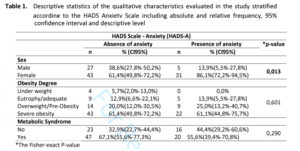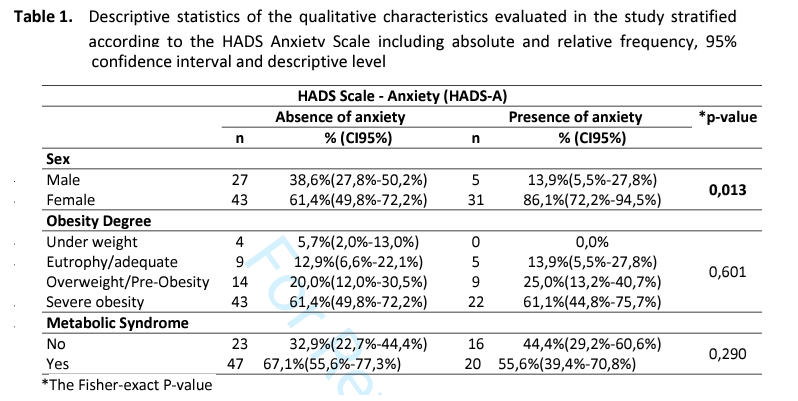HIGHLIGHTS
- Depression and anxiety have also been a very frequent disorder worldwide; however, few are the studies which relate anxiety to MASLD.
- Data by the WHO demonstrate that Brazil has the highest rate of anxiety (9.3%) and is one of the main countries with high numbers of depression cases (5.8%).
- Recent studies have shown a link between depression and MASLD, as well as a close link between anxiety and MetS, suggesting a higher probability of patients with MASLD having anxiety.
- However, the link between depression, anxiety and MASLD is still inconsistent, since some studies show a positive association, and others did not reach any association.
ABSTRACT – Background –
This study aimed to assess the frequency and intensity of anxious and depressive symptoms in patients diagnosed with metabolic dysfunction-associated steatotic liver disease (MASLD). Methods – This is a descriptive and cross-sectional study, resulting from 106 patients from the Hepatology outpatient clinic at the Hospital das Clínicas da Faculdade de Medicina da Universidade de São Paulo (HCFMUSP), São Paulo, Brazil without a history of alcohol abuse, verified by the alcohol use disorders identification test (AUDIT). These were assessed using the sociodemographic data sheet, Hospital Anxiety and Depression Scale (HADS), Hamilton Anxiety Rating Scale (HAM-A), and Hamilton Depression Scale (HAM-D). Results – A total of 69.8% were women and 30.2% were men, with a mean age of 61 years. The majority (71.7%) discovered MASLD through routine exams, presenting as comorbidities: Type 2 diabetes mellitus (59.4%), Dyslipidemia (49.1%), Arterial hypertension (68.9%), Obesity (61.3%) and Metabolic syndrome [MetS (63.2%)]. The HADS scale indicates 34% probability of anxiety and 33% depressive symptoms. The Hamilton’s scales of intensity indicates 63.9% severe anxiety and 54.3% severe depression. There is also a relationship between anxiety, depression and the female gender, as well as between depression and MetS. Conclusion – The findings point to the presence of anxiety and depression in more than one third of MASLD patients, most with severe symptoms. The group is concentrated in the elderly, with many comorbidities, including MetS. There was a positive correlation between anxiety, depression and being female; also, being significant between MetS and depression.
AUTORES
Eloyse Cristina BOTACIN1, Sebastião Mauro Bezerra DUARTE1, José Tadeu STEFANO1, Mary Ellen Dias BARBOSA1, Mario Guimarães PESSOA1,2 and Cláudia P OLIVEIRA1,2



